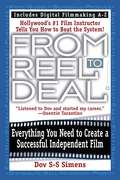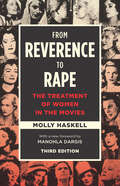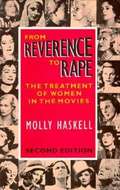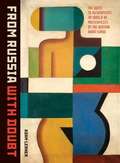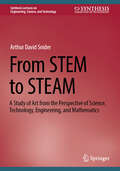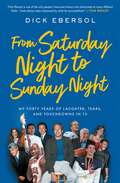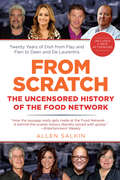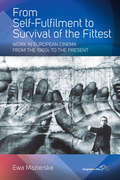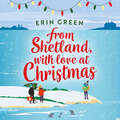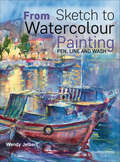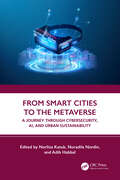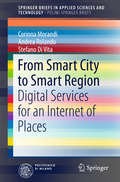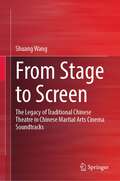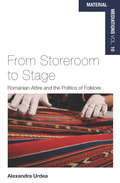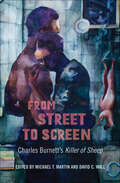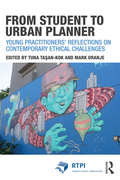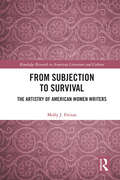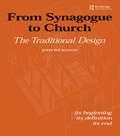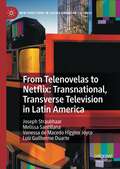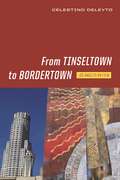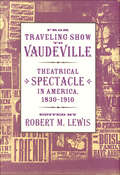- Table View
- List View
From Reel to Deal: Everything You Need to Create a Successful Independent Film
by Dov S-S SimensFrom screenwriting & budgeting to marketing, Simens provides encyclopedic, precise, & creative instruction for putting your vision up on the screen.
From Reverence to Rape: The Treatment of Women in the Movies
by Molly HaskellThe “groundbreaking study” of female representation in film, now with a new introduction by the author (New York Times Book Review).A landmark of feminist cinema criticism, Molly Haskell’s From Reverence to Rape remains as insightful, searing, and relevant as it was when it first appeared in 1974. Ranging across time and genres from the golden age of Hollywood to films of the late twentieth century, Haskell analyzes images of women in movies, the relationship between these images and the status of women in society, the stars who fit these images or defied them, and the attitudes of their directors. This new edition features both a new foreword by New York Times film critic Manohla Dargis and a new introduction from the author that discusses the book’s reception and the evolution of her views.
From Reverence to Rape: The Treatment of Women in the Movies (2nd edition)
by Molly HaskellMolly Haskell has written a new chapter addressing recent developments in the appearance and perception of women in the movies.
From Russia With Doubt
by Adam LernerIn 2010 the Museum of Contemporary Art Denver director Adam Lerner did something unheard of in the museum world: he mounted a large exhibition of paintings without first knowing whether they were real or fakes. Painted in the Suprematist and Constructivist style of early twentieth-century Russian avant-garde masters, the 181 canvases had been acquired by amateur collectors Ron and Roger Pollard from a mysterious seller in Germany they met on eBay who claimed the paintings were found in an abandoned shipping container held in German customs since the 1980s. In From Russia with Doubt, Lerner skillfully weaves together the tale--from the initial eBay find to his controversial decision to exhibit the collection--guiding readers through the looking glass into the Byzantine corridors of the art world and beyond, describing the owners' quest to authenticate and appraise the would-be masterpieces. What he finds raises powerful questions about our own relationship to art.
From STEM to STEAM: A Study of Art from the Perspective of Science, Technology, Engineering, and Mathematics (Synthesis Lectures on Engineering, Science, and Technology)
by Arthur David SniderThis book provides readers with an introductory overview of art from the perspective of science, technology, engineering, and mathematics. The author utilizes well-known and important works of art to demonstrate how STEM concepts apply to them. The book’s examples include a structural analysis of Michelangelo’s David. The author covers major breakthroughs in art history, such as the discovery of perspective. The book also discusses other important elements of art, such as color, from a scientific point of view. The author ensures that readers will understand the art terms used by comparing them with terms used in STEM fields of study.
From Saturday Night to Sunday Night: My Forty Years of Laughter, Tears, and Touchdowns in TV
by Dick EbersolA memoir by the legendary television executive detailing his pioneering work on Saturday Night Live, Sunday Night Football, the Olympics, the NBA, music videos, late night, and more.Think of an important moment in live TV over the last half-century. Dick Ebersol was likely involved. Dropping out of college to join the crew of ABC&’s Wide World of Sports, Ebersol worked the Mexico City Olympics during the famous protest by John Carlos and Tommie Smith as well as the Munich Olympics during the tragic hostage standoff. He went on to cocreate Saturday Night Live with Lorne Michaels and later produced the show for four seasons, helping launch Eddie Murphy to stardom. After creating Friday Night Videos and partnering with Vince McMahon to bring professional wrestling to network TV, he next took over NBC Sports, which helped turn basketball into a global phenomenon and made history as the first broadcaster to host the World Series, the Super Bowl, the NBA Finals, and the Summer Olympics in the same year; it was Ebersol who was responsible for Muhammad Ali lighting the Olympic flame in Atlanta. Then, following a plane crash that took the life of his fourteen-year-old son Teddy and nearly killed him, he determinedly undertook perhaps his greatest career achievement: creating NBC&’s Sunday Night Football, still the #1 primetime show in America. The Today show&’s headline-making hosting changes, the so-called &“Late-Night Wars,&” O.J. Simpson&’s Bronco chase—Ebersol had a front-row seat to it all. From Saturday Night to Sunday Night is filled with entertaining and illuminating stories featuring such boldface names as Billy Crystal, Michael Jordan, Bill Clinton, Jay Leno, Peyton Manning, Michael Phelps, and Larry David. (Ebersol even inspired the famous Seinfeld episode in which George Costanza pretends he didn&’t quit his job.) More than that, the book offers an insightful history and analysis of TV&’s evolution from broadcast to cable and beyond—a must-read for casual binge-watchers and small-screen aficionados alike.
From Scratch
by Allen SalkinBig personalities, high drama-the extraordinary behind-the-scenes story of the Food Network, now about to celebrate its twentieth anniversary: the business, media, and cultural juggernaut that changed the way America thinks about food. In October 1993, a tiny start-up called the Food Network debuted to little notice. Twenty years later, it is in 100 million homes, approaches a billion dollars a year in revenue, and features a galaxy of stars whose faces and names are as familiar to us as our own family’s. But what we don’t know about them, and the people behind them, could fill a book. Based upon extensive inside access, documents, and interviews with hundreds of executives, stars, and employees all up and down the ladder, Allen Salkin’s book is an exhilarating roller-coaster ride from chaos to conquest (and sometimes back). As Salkin takes us inside the conference rooms, studios, homes, restaurants, and after-hours meetings, we see a salty Julia Child lording it over the early network performers; a fragile Emeril Lagasse staggering from the sudden public shock of cancellation; a very green Rachael Ray nearly burning down the set on her first day; a torn Tyler Florence accepting the Applebee’s job he knows he can’t refuse, but with a chill running down his spine; a determined Bobby Flay reinventing himself once again to survive. Paula Deen, Tom Colicchio, Anthony Bourdain, Mario Batali, Jamie Oliver, Martha Stewart, Guy Fieri, Cat Cora: Salkin illuminates the people we thought we knew, and the ones we never knew about, in this irresistible story of the intersection between business, television, pop culture, food-and us. .
From Scratch
by Allen SalkinTwenty Years of Dish from Flay and Fieri to Deen and DeLaurentiis... Includes a New Afterword! I don t want this shown. I want the tapes of this whole series destroyed. Martha Stewart In those days, the main requirement to be on the Food Network was being able to get there by subway. Bobby Flay She seems to suggest that you can make good food easily, in minutes, using Cheez Whiz and chopped-up Pringles and packaged chili mix. Anthony Bourdain This is the definitive history of The Food Network from its earliest days as a long-shot business gamble to its current status as a cable obsession for millions, home along the way to such icons as Emeril Lagasse, Rachael Ray, Mario Batali, Alton Brown, and countless other celebrity chefs. Using extensive inside access and interviews with hundreds of executives, stars, and employees, From Scratch is a tantalizing, delicious look at the intersection of business, pop culture, and food. INCLUDES PHOTOS But what we don't know about them, and the people behind them, could fill a book. Based upon extensive inside access, documents, and interviews with hundreds of executives, stars, and employees all up and down the ladder, Allen Salkin's book is an exhilarating roller-coaster ride from chaos to conquest (and sometimes back). As Salkin takes us inside the conference rooms, studios, homes, restaurants, and after-hours meetings, we see a salty Julia Child lording it over the early network performers; a fragile Emeril Lagasse staggering from the sudden public shock of cancellation; a very green Rachael Ray nearly burning down the set on her first day; a torn Tyler Florence accepting the Applebee's job he knows he can't refuse, but with a chill running down his spine; a determined Bobby Flay reinventing himself once again to survive. Paula Deen, Tom Colicchio, Anthony Bourdain, Mario Batali, Jamie Oliver, Martha Stewart, Guy Fieri, Cat Cora: Salkin illuminates the people we thought we knew, and the ones we never knew about, in this irresistible story of the intersection between business, television, pop culture, food--and us.
From Self-fulfilment to Survival of the Fittest: Work in European Cinema from the 1960s to the Present
by Ewa MazierskaContrary to the assumption that Western and Eastern European economies and cinemas were very different from each other, they actually had much in common. After the Second World War both the East and the West adopted a mixed system, containing elements of both socialism and capitalism, and from the 1980s on the whole of Europe, albeit at an uneven speed, followed the neoliberal agenda. This book examines how the economic systems of the East and West impacted labor by focusing on the representation of work in European cinema. Using a Marxist perspective, it compares the situation of workers in Western and Eastern Europe as represented in both auteurist and popular films, including those of Tony Richardson, Lindsay Anderson, Jean-Luc Godard, Andrzej Wajda, DušanMakavejev, Jerzy Skolimowski, the Dardenne Brothers, Ulrich Seidl and many others.
From Shetland, With Love at Christmas: The ultimate heartwarming, seasonal treat of friendship, love and creative crafting!
by Erin Green'A warm, funny, uplifting writer to celebrate!' KATIE FFORDEIf you love Lucy Diamond, Phillipa Ashley, Sue Moorcroft and Holly Martin, you'll LOVE Erin Green's novels of love, life and laughter!Readers are enchanted by From Shetland, With Love at Christmas!'A lovely Christmas read . . . made me feel good. Excellent''An essential for anyone's pre-Christmas light and relaxing reading list''I couldn't put this book down it was that good. . . 10 stars at least''A wonderful festive read that makes you wish you were there''This was a beautiful escapist read''Great characters, great storyline and a big hug in book form will be found within the pages of this amazing festive book. Loved it''A lovely story of friendship, love, and starting over. I wish I lived in this town, could shop at their stores and be friends with these lovely characters'...........................................................................Friendship can be the greatest gift you'll ever give...Verity is embarking on a better-late-than-never gap year now that her sons have flown the nest, and dreams of turning a lifetime's hobby of knitting and crocheting into a profitable new enterprise at Lerwick Manor's gallery. Nessie has returned to Shetland after two years spent retraining as a blacksmith on the Scottish mainland. She's determined to do whatever it takes to reignite the traditional craft and prove that gender is no obstacle to taking on her family's heritage. Isla is fresh out of catering college, but she is desperate to prove she has what it takes to run Lerwick Manor's artisan café. Focused on perfecting her grandmother's traditional recipes, Isla has no time for anything else - especially not her pesky ex.With the island's Yule Day celebration fast approaching, it's the ideal moment for their crafts to shine. But they can't do it alone - and their friendship might turn out to be their greatest creation yet..............................................................................'A perfect story full of hope, love and friendship' 5* reader review'An uplifting, engaging and heart warming book. Loved it' 5* reader review'An amazing book and makes you really think that your dreams of changing your life can really happen' 5* reader review'The author has the knack of making her characters spring off the pages so real that you'll care about them' Peterborough TelegraphDon't miss Erin's uplifting From Shetland, With Love - out now!You are invited to holiday at gorgeous Rose Cottage - where friendship, home comforts and romance are guaranteed... look for New Beginnings at Rose Cottage - out now! - 'Utterly charming...an uplifting and optimistic story' Hot Brands Cool PlacesIf you don't ask you'll never know... don't miss Taking a Chance on Love - out now!
From Shetland, With Love at Christmas: The ultimate heartwarming, seasonal treat of friendship, love and creative crafting!
by Erin Green'A warm, funny, uplifting writer to celebrate!' KATIE FFORDEIf you love Lucy Diamond, Phillipa Ashley, Sue Moorcroft and Holly Martin, you'll LOVE Erin Green's novels of love, life and laughter!Readers are enchanted by From Shetland, With Love at Christmas!'A lovely Christmas read . . . made me feel good. Excellent''An essential for anyone's pre-Christmas light and relaxing reading list''I couldn't put this book down it was that good. . . 10 stars at least''A wonderful festive read that makes you wish you were there''This was a beautiful escapist read''Great characters, great storyline and a big hug in book form will be found within the pages of this amazing festive book. Loved it''A lovely story of friendship, love, and starting over. I wish I lived in this town, could shop at their stores and be friends with these lovely characters'...........................................................................Friendship can be the greatest gift you'll ever give...Verity is embarking on a better-late-than-never gap year now that her sons have flown the nest, and dreams of turning a lifetime's hobby of knitting and crocheting into a profitable new enterprise at Lerwick Manor's gallery. Nessie has returned to Shetland after two years spent retraining as a blacksmith on the Scottish mainland. She's determined to do whatever it takes to reignite the traditional craft and prove that gender is no obstacle to taking on her family's heritage. Isla is fresh out of catering college, but she is desperate to prove she has what it takes to run Lerwick Manor's artisan café. Focused on perfecting her grandmother's traditional recipes, Isla has no time for anything else - especially not her pesky ex.With the island's Yule Day celebration fast approaching, it's the ideal moment for their crafts to shine. But they can't do it alone - and their friendship might turn out to be their greatest creation yet..............................................................................'A perfect story full of hope, love and friendship' 5* reader review'An uplifting, engaging and heart warming book. Loved it' 5* reader review'An amazing book and makes you really think that your dreams of changing your life can really happen' 5* reader review'The author has the knack of making her characters spring off the pages so real that you'll care about them' Peterborough TelegraphDon't miss Erin's uplifting From Shetland, With Love - out now!You are invited to holiday at gorgeous Rose Cottage - where friendship, home comforts and romance are guaranteed... look for New Beginnings at Rose Cottage - out now! - 'Utterly charming...an uplifting and optimistic story' Hot Brands Cool PlacesIf you don't ask you'll never know... don't miss Taking a Chance on Love - out now!
From Shetland, With Love at Christmas: The ultimate heartwarming, seasonal treat of friendship, love and creative crafting! (From Shetland, With Love #2)
by Erin GreenSpend your holiday season with the Christmas listen you don't want to miss in Erin Green's uplifting novel of love, friendship and changing your life!If you love Lucy Diamond, Phillipa Ashley, Sue Moorcroft and Holly Martin, you'll LOVE Erin Green's novels of love, life and laughter!'Utterly charming...an uplifting and optimistic story' Hot Brands Cool Places on New Beginnings at Rose Cottage'A perfect story full of hope, love and friendship' 5* reader review'An uplifting, engaging and heart warming book. Loved it' 5* reader review'An amazing book and makes you really think that your dreams of changing your life can really happen' 5* reader review'The author has the knack of making her characters spring off the pages so real that you'll care about them' Peterborough TelegraphFriendship can be the greatest gift you'll ever give...Verity is embarking on a better-late-than-never gap year now that her sons have flown the nest, and dreams of turning a lifetime's hobby of knitting and crocheting into a profitable new enterprise at Lerwick Manor's gallery. Nessie has returned to Shetland after two years spent retraining as a blacksmith on the Scottish mainland. She's determined to do whatever it takes to reignite the traditional craft and prove that gender is no obstacle taking on her family's heritage. Isla is fresh out of catering college, but she is desperate to prove she has what it takes to run Lerwick Manor's artisan café. Focused on perfecting her grandmother's traditional recipes, Isla has no time for anything else - especially not her pesky ex.With the island's Yule Day celebration fast approaching, it's the ideal moment for their crafts to shine. But they can't do it alone - and their friendship might turn out to be their greatest creation yet...Don't miss Erin's uplifting From Shetland, With Love - out now!You are invited to holiday at gorgeous Rose Cottage - where friendship, home comforts and romance are guaranteed... look for New Beginnings at Rose Cottage - out now!If you don't ask you'll never know... don't miss Taking a Chance on Love - out now!(P) 2021 Headline Publishing Group Ltd
From Sketch to Watercolour Painting: Pen, Line and Wash
by Wendy JelbertA complete and inspirational course for all those who love to sketch and paint.Pen and wash is a loose, fresh watercolour technique that is ideal for sketching; but it can also be used to produce beautiful finished artworks. Through a series of step-by-step projects, Wendy Jelbert demonstrates how to develop your sketching skills and to transform your sketches of inspirational scenes and special moments into beautiful finished artworks. Fill your paintings with life, energy and colour, and learn how to share your artistic world with those around you.
From Slave Ship to Freedom Road
by Julius Lester"From Slave Ship to Freedom Road" presents the story of slavery from its beginnings on the infamous ships of the Middle Passage to the enslaved Africans and their descendants.
From Smart Cities to the Metaverse: A Journey through Cybersecurity, AI, and Urban Sustainability
by Norliza Katuk Noradila Nordin Adib HabbalThis book offers a comprehensive exploration of the convergence between smart city infrastructure and the emerging metaverse. This book highlights the importance of integrating advanced technologies such as artificial intelligence, virtual reality/augmented reality, and blockchain to enhance urban living experiences while addressing such innovations’ security and ethical challenges. Its applications span urban planning, transportation, education, historic preservation, and inclusive city development, making it an essential resource for modern urban development.The book covers many key areas critical to understanding and implementing smart cities and the metaverse. It starts with both domains’ foundational concepts and technological underpinnings, followed by a deep dive into the security infrastructure and challenges smart cities face. Cybersecurity is given special attention, exploring motives and methods of cyberattacks and proposing mitigation techniques and best practices. The book also examines AI chatbots, intelligent transportation, and the integration of digital twins, providing practical case studies and insights. Furthermore, it addresses the socioeconomic implications, governance, and ethical considerations, ensuring a holistic approach to the subject.The motivation for writing this book stems from the contributors’ recognition of the transformative potential of smart cities and the metaverse in creating sustainable, efficient, and inclusive urban environments. By bridging the gap between theoretical research and practical application, the contributors aim to equip researchers, policymakers, and technologists with the knowledge and tools needed to navigate and shape the future of urban living in a digitally interconnected world.
From Smart City to Smart Region
by Corinna Morandi Andrea Rolando Stefano Di VitaThis book offers a fascinating exploration of the relationship between information and communication technologies (ICTs) and spatial planning, expanding the concept of "urban smartness" from the usual scale of buildings or urban projects to the regional dimension. In particular, it presents the outcomes of research undertaken at Politecnico di Milano, in collaboration with Telecom Italia, that had three principal goals: to investigate the use of ICTs for the representation, promotion, management, and dissemination of an integrated system of services; to explore the spatial impacts of digital services at different scales (regional, urban, local); and to understand how a system of mobile services can encourage new spatial uses and new collective behavior in the quest for better spatial quality of places. Useful critical analysis of international case studies is also included with the aim of verifying the opportunities afforded by new digital services not only to improve the urban efficiency but also to foster the evolution of urban communities through enhancement of the public realm. The book will be a source of valuable insights for both scholars and local administrators and operators involved in smart city projects.
From Stage to Screen: The Legacy of Traditional Chinese Theatre in Chinese Martial Arts Cinema Soundtracks
by Shuang WangChinese martial arts cinema is held to be a synthesis drawing on artistic conventions of traditional Chinese theatre. Film sound and music perform as the legitimate heirs of some of the aesthetic ideas and norms of traditional Chinese theatre. This book critically examines the history of this under-explored field of inquiry from a theoretically comparative perspective, demonstrating that the musical codes drawn from traditional theatre are a constantly changing component integral to Chinese martial arts cinema. It explores the interaction between traditional Chinese theatre and Chinese martial arts cinema in how the musical codes of the former have shaped the aesthetics of the latter uniquely. This departs from conventional existing studies that focus on “adaptation.” The book’s historical and theoretical approach connects film, theatre and music, and re-defines the status of distinctive domains of filmic expression, grounding theatre as the pivot – or “hinge” – of film aesthetics. The book proffers this unique angle of research to rethink and re-imagine film sound and audiovisual synchronisation. Primarily intended for scholars in Chinese cinema, film music, Chinese theatre and visual culture, this monograph also presents introductory and comprehensive material for undergraduate and graduate-level courses in film and media studies, film music, Chinese cinema, and Chinese theatre.
From Storeroom to Stage: Romanian Attire and the Politics of Folklore (Material Mediations: People and Things in a World of Movement #10)
by Alexandra UrdeaDeparting from an ethnographic collection in London, From Storeroom to Stage traces the journey of its artefacts back to the Romanian villages where they were made 70 years ago, and to other places where similar objects are still in use. The book explores the role that material culture plays in the production of value and meaning by examining how folk objects are mobilized in national ideologies, transmissions of personal and family memory, museological discourses, and artistic acts.
From Street to Screen: Charles Burnett's Killer of Sheep (Studies in the Cinema of the Black Diaspora)
by Michael T. Martin and David C. WallCharles Burnett's 1977 film, Killer of Sheep is one of the towering classics of African American cinema. As a deliberate counterpoint to popular blaxploitation films of the period, it combines harsh images of the banality of everyday oppression with scenes of lyrical beauty, and depictions of stark realism with flights of comic fancy. From Street to Screen: Charles Burnett's Killer of Sheep is the first book-length collection dedicated to the film and designed to introduce viewers to this still relatively unknown masterpiece. Beginning life as Burnett's master's thesis project in 1973, and shot on a budget of $10,000, Killer of Sheep immediately became a cornerstone of the burgeoning movement in African American film that came to be known variously as the LA School or LA Rebellion. By bringing together a wide variety of material, this volume covers both the politics and aesthetics of the film as well as its deeper social and contextual histories. This expansive and incisive critical companion will serve equally as the perfect starting point and standard reference for all viewers, whether they are already familiar with the film or coming to it for the first time.
From Student to Urban Planner: Young Practitioners’ Reflections on Contemporary Ethical Challenges (RTPI Library Series)
by Tuna Taşan-Kok Mark OranjeFor many young planners, the noble intentions with going to planning school seem starkly out of place in the neoliberal worlds they have come to inhabit. For some, the huge gap between the power they thought they would have and what they actually do is not only worrying, but also deeply discouraging. But for some others, practice means finding practical and creative solutions to overcome challenges and complexities. How do young planners in different settings respond to seemingly similar situations like these? What do they do – give up, adjust, or fight back? What role did their planning education play, and could it have helped in preparing and assisting them to respond to the world they are encountering? In this edited volume, stories of young planners from sixteen countries that engage these questions are presented. The sixteen cases range from settings with older, established planning systems (e.g., USA, the Netherlands, and the UK) to settings where the system is less set (e.g., Brazil), being remodeled (e.g., South Africa and Bosnia Herzegovina), and under stress (e.g., Turkey and Poland). Each chapter explores what might be done differently to prepare young planners for the complexities and challenges of their ‘real worlds’. This book not only points out what is absent, but also offers planning educators an alternative vision. The editors and esteemed contributors provide reflections and suggestions as to how this new generation of young planners can be supported to survive in, embrace, and change the world they are encountering, and, in the spirit of planning, endeavor to ‘change it for the better’.
From Subjection to Survival: The Artistry of American Women Writers (Routledge Research in American Literature and Culture)
by Molly J. FreitasFrom Subjection to Survival is a work of feminist scholarship that works at the intersection of literature and art history, the written and the visual. By examining six important and diverse multiethnic American women writers of the twentieth century (Kate Chopin, Anzia Yezierska, Edith Wharton, Zitkala-Ša, Nella Larsen, and Helena María Viramontes), From Subjection to Survival establishes a genealogy of how women writers claim the power and possibility of visual art to make sense of their experiences. These writers write about women and feature female protagonists who engage with art as painters, writers, muses, or icons in the texts themselves. The texts are written visually to expose the fundamental substantiation of gender in art and the unavoidable aestheticization of women in daily life. As every text in this book makes clear, women can claim substantial power through art. Yet, aestheticization is not always positive. As a consequence of such negative possibilities, the artistic self-referentiality of all of the texts in From Subjection to Survival exposes a negotiated course between subjectivity and objectness which women experience when engaging with art. From Subjection to Survival studies this negotiated course to lay bare the difficult path of women’s artistic and aesthetic experience, but ultimately to claim the power and the possibility of the visual arts for women.
From Synagogue to Church: Its Beginning, its Definition, its End (Routledge Jewish Studies Series)
by John WilkinsonThe designs of synagogues and churches are acknowledged to be very alike. But the designers' procedure was confidential, and so far standard explanations have been unsatisfactory. A synagogue should express heavenly values with earthly materials. This combination was in fact expressed in numbers, for, as Plato said, they linked heaven and earth. Scripture described both the Jewish Tabernacle and Temple with a wealth of numbers. Proportions based on these numbers were used to design synagogues. Only a few Jewish documents survive, but they reveal a symbolism, which Christians sometimes repeat. The synagogue sanctuary was designed to contain the 'Holy Ark', and the mosaic floors reveal the point 'Before the Ark' for the prayers and readings. These places faced each other, with the idea that God was facing his people. The synagogue was seen as facing heaven and in church buildings Christians repeated the same proportions. This was a joint tradition among Jews and Christians. It was easy to design, was carried out secretly and accurately, and - without a computer - was extremely hard to unravel. This book, for the first time, does just that.
From Telenovelas to Netflix: Transnational, Transverse Television in Latin America (New Directions in Latino American Cultures)
by Joseph Straubhaar Melissa Santillana Vanessa de Macedo Higgins Joyce Luiz Guilherme DuarteThis book is about television in Latin America. Its national and regional industries create most television programming there within genres developed over time in the region. However, part of the programming has always come from the U.S., Europe and elsewhere. With cable, satellite and now streaming TV, that inflow of foreign programming has increased substantially. While many in the audience still prefer national or regional programs for their cultural proximity, an increasing number among the upper-middle and middle classes, particularly the young, are turning to the new foreign services, like Netflix, Amazon and Disney for class distinction, cosmopolitanism or other motives. Among the television industries, global, regional and national actors are creating a variety of programs and channels (broadcast, pay-TV and streaming) to segment and appeal to different parts of the audience.
From Tinseltown to Bordertown: Los Angeles on Film (Contemporary Approaches to Film and Media Series)
by Celestino DeleytoLos Angeles is a global metropolis whose history and social narrative is linked to one of its top exports: cinema. L.A. appears on screen more than almost any city since Hollywood and is home to the American film industry. Historically, conversations of social and racial homogeneity have dominated the construction of Los Angeles as a cosmopolitan city, with Hollywood films largely contributing to this image. At the same time, the city is also known for its steady immigration, social inequalities, and exclusionary urban practices, not dissimilar to any other borderland in the world. The Spanish names and sounds within the city are paradoxical in relation to the striking invisibility of its Hispanic residents at many economic, social, and political levels, given their vast numbers. Additionally, the impact of the 1992 Los Angeles riots left the city raw, yet brought about changing discourses and provided Hollywood with the opportunity to rebrand its hometown by projecting to the world a new image in which social uniformity is challenged by diversity. It is for this reason that author Celestino Deleyto decided to take a closer look at how the quintessential cinematic city contributes to the ongoing creation of its own representation on the screen. From Tinseltown to Bordertown: Los Angeles on Film starts from the theoretical premise that place matters. Deleyto sees film as predominantly a spatial system and argues that the space of film and the space of reality are closely intertwined in complex ways and that we should acknowledge the potential of cinema to intervene in the historical process of the construction of urban space, as well as its ability to record place. The author asks to what extent this is also the city that is being constructed by contemporary movies. From Tinseltown to Bordertown offers a unique combination of urban, cultural, and border theory, as well as the author’s direct observation and experience of the city’s social and human geography with close readings of a selection of films such as Falling Down, White Men Can’t Jump, and Collateral. Through these textual analyses, Deleyto tries to situate filmic narratives of Los Angeles within the city itself and find a sense of the “real place” in their fictional fabrications. While in a certain sense, Los Angeles movies continue to exist within the rather exclusive boundaries of Tinseltown, the special borderliness of the city is becoming more and more evident in cinematic stories. Deleyto’s monograph is a fascinating case study on one of the United States’ most enigmatic cities. Film scholars with an interest in history and place will appreciate this book.
From Traveling Show to Vaudeville: Theatrical Spectacle in America, 1830–1910
by Robert M. LewisBefore phonographs and moving pictures, live performances dominated American popular entertainment. Carnivals, circuses, dioramas, magicians, mechanical marvels, musicians, and theatrical troupes—all visited rural fairgrounds, small-town opera houses, and big-city palaces around the country, giving millions of people an escape from their everyday lives for a dime or a quarter. In From Traveling Show to Vaudeville, Robert M. Lewis has assembled a remarkable collection of nineteenth- and early twentieth-century primary sources that document America's age of theatrical spectacle. In eight parts, Lewis explores, in turn, dime museums, minstrelsy, circuses, melodramas, burlesque shows, Wild West shows, amusement parks, and vaudeville.Included in this compendium are biographies, programs, ephemera produced by theatrical entrepreneurs to lure audiences to their shows, photographs, scripts, and song lyrics as well as newspaper accounts, reviews, and interviews with such figures as P. T. Barnum and Buffalo Bill Cody. Lewis also gives us reminiscences about and reactions to various shows by members of audiences, including such prominent writers as Mark Twain, William Dean Howells, Nathaniel Hawthorne, Carl Sandburg, Walt Whitman, Louisa May Alcott, Charles Dickens, O. Henry, and Maxim Gorky. Each section also includes a concise introduction that places the genre of spectacle into its historical and cultural context and suggests major interpretive themes. The book closes with a bibliographic essay that identifies relevant scholarly works.Many of the pieces collected here have not been published since their first appearance, making From Traveling Show to Vaudeville an indispensable resource for historians of popular culture, theater, and nineteenth-century American society.
